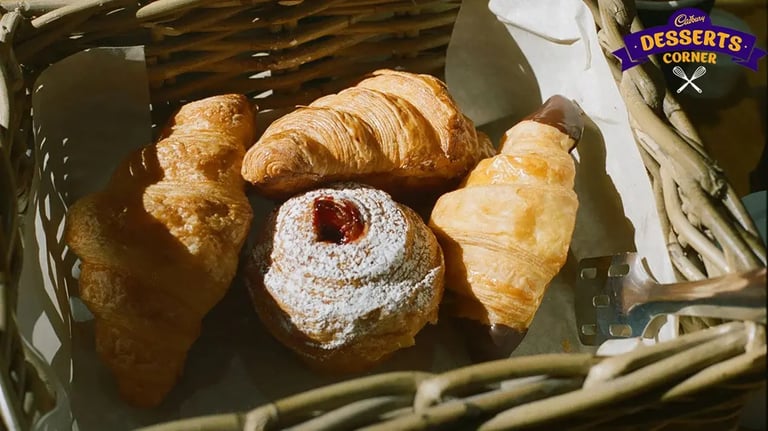- Home
- Articles
- Celebrate National Pastry Day With a Selection of Desserts and Their Specific Techniques
Pastries, unlike the regular cake fare, use fewer ingredients. But what they lack in ingredients is made up of specific techniques that need some time to master. Croissants, danishes, and eclairs are all delicate, and need the dough to be kneaded, flattened, and rolled in a certain manner to give rise to their iconic shape.

Pastries, unlike the regular cake fare, use fewer ingredients. But what they lack in ingredients is made up of specific techniques that need some time to master. Croissants, danishes, and eclairs are all delicate, and need the dough to be kneaded, flattened, and rolled in a certain manner to give rise to their iconic shape.
December 9th marks World Pastry Day, an annual occasion for pastry lovers worldwide to acknowledge the artistry behind their favorite sweet treats. While not an officially recognized holiday, the day has emerged as an informal opportunity to pay homage to pastry chefs' dedication to their craft.
From intricate croissants to colorful macarons, pastries have evolved over centuries into delicate works of edible art, with distinct styles found across cultures. Whether enjoying a morning pastry with coffee or indulging in desserts, baked goods hold significance in many communities globally.
Some Popular Pastry Desserts
All pastries are cakes but not all cakes are desserts, and that slice of cake with frosting on top is called a pastry in colloquial terms, but technically, pastries employ only minimal ingredients to result in delicious desserts. Here are some of the most common ones that are popular:
Croissants

This crescent-shaped pastry is what defines France in general, Paris to be exact with a mustached man in a red beret holding a baguette and croissants floating in the sky. Such is the image, but stereotypes aside, croissants, especially with sweet fillings like chocolate or jam, are a treat to have.
Cannoli

Crisp pastry shells filled with sweet ricotta cheese and candied fruit are tricky to make but such a delight to have especially with movies like The Godfather etching it on the Italian dessert-scape.
Danish

Light, flaky pastries often filled with fruit preserves or creamy fillings. Denmark's most famous contribution to the pastry world, Danishes are made from yeast dough rolled out,topped and folded with butter, and sometimes an egg wash. Common varieties include apple, cherry, raspberry and custard-filled pastries.
Baklava

Thin layers of phyllo dough filled with a nut mixture of chopped nuts like walnuts or pistachios and sweetened with honey or syrup. Baked until crisp and golden, it results in a buttery, flaky pastry with a sweet, sticky filling. Popular in Greece and throughout the Middle East, it's a beloved specialty for celebrations.
Profiteroles
Light, airy choux pastry piped or scooped and baked into balls, cylinders or teardrop shapes. Often filled with pastry cream, ice cream, chocolate sauce or whipped cream after baking. The French classic hails from 18th-century Paris and remains a popular dessert or appetizer in boulangeries.
Éclairs
Long, cylindrical desserts made of choux pastry, similar to the base of profiteroles. Piped or scooped and baked, éclairs are hollow inside and often filled with pastry cream or flavored creams. The light, airy pastry shells are crisp on the outside and soft within. Topped with icing or chocolate, éclairs are an elegant French pastry enjoyed as an afternoon snack or dessert.
Macarons
Iconic French sandwich cookies consisting of two smooth, domed shells sandwiched together with a creamy filling. The meringue-based shells are piped and baked to develop a shiny, cracked surface and chewy-soft texture. Fillings can be buttercream, ganache, or fruit-flavored curds. Subtle or bold flavor combinations distinguish high-end macarons, which require precise technique and timing to execute properly. Their delicate nature and vibrant colors have made macarons globally beloved and the most recognized treat.
Common Techniques Needed for Pastries
Lamination
Used for puff pastry and croissants. Sheets of dough are rolled out and have a layer of chilled butter spread over them. The dough is then folded over, rolled and folded/turned repeatedly to create hundreds of ultra-thin layers when baked.
Piping
Éclairs, profiteroles, and cream puffs are piped from the choux pastry using round tips. Macarons use smaller tips to pipe batter into rounds. Danish and other filled pastries may use star tips to create decorative edges.
Filling and assembly
Éclairs, cream puffs and profiteroles are hollow shells meant to be filled through an opening with pastry cream, custard, or whipped cream. Macarons and cream sandwiches require carefully filling the sandwich without overfilling. Baklava and other layered pastries need an even distribution of filling between delicate phyllo or puff pastry layers.
Icing/Decorating
From dusting powdered sugar over cream puffs and éclairs to outlining Danish or piping intricate designs on cakes, icing brings polish. Macarons are often sandwiched with buttercream or ganache and then topped with additional decoration.
Meringue
Used primarily for pies, cookies, macarons and other items where a light, airy texture is desired. Meringue is made by beating egg whites with sugar until thick and fluffy. A stable meringue forms when the proteins in the egg whites bond with the sugar.
More Like This
Popular Articles



Trending Web Stories
Curated Recipes


















